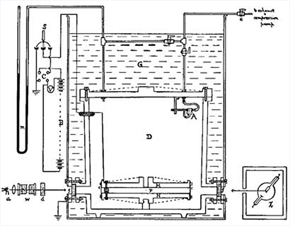August, 1913: Robert Millikan Reports His Oil Drop Results
 Diagram of Millikan's apparatus, from his Physical Review paper |
Robert Millikan’s famous oil drop experiment, reported in August 1913, elegantly measured the fundamental unit of electric charge. The experiment, a great improvement over previous attempts to measure the charge of an electron, has been called one of the most beautiful in physics history, but is also the source of allegations of scientific misconduct on Millikan’s part.
Robert Millikan was born in 1868 and grew up in rural Iowa, the second son of a minister. Millikan attended Oberlin College, earned his PhD from Columbia University, and then spent a year in Germany before taking a position at the University of Chicago.
By about 1906, Millikan had become a successful educator and textbook writer, but he knew that he hadn’t done any research of real scientific significance, and was eager to make his mark as a researcher.
J.J. Thomson had discovered the electron in 1897 and had measured its charge-to-mass ratio. The next step was to determine the electron’s charge separately. Thomson and others tried to measure the fundamental electric charge using clouds of charged water droplets by observing how fast they fell under the influence of gravity and an electric field. The method did give a crude estimate of the electron’s charge.
Millikan saw this opportunity to make a significant contribution by improving upon these measurements. He realized that trying to determine the charge on individual droplets might work better than measuring charge on whole clouds of water. In 1909 he began the experiments, but soon found that droplets of water evaporated too quickly for accurate measurement. He asked his graduate student, Harvey Fletcher, to figure out how to do the experiment using some substance that evaporated more slowly.
Fletcher quickly found that he could use droplets of oil, produced with a simple perfume atomizer. The oil droplets are injected into an air-filled chamber and pick up charge from the ionized air. The drops then fall or rise under the combined influence of gravity, viscosity of the air, and an electric field, which the experimenter can adjust. The experimenter could watch the drops through a specially designed telescope, and time how fast a drop falls or rises. After repeatedly timing the rise and fall of a drop, Millikan could calculate the charge on the drop.
In 1910 Millikan published the first results from these experiments, which clearly showed that charges on the drops were all integer multiples of a fundamental unit of charge. But after the publication of those results, Viennese physicist Felix Ehrenhaft claimed to have conducted a similar experiment, measuring a much smaller value for the elementary charge. Ehrenhaft claimed this supported the idea of the existence of “subelectrons.”
Ehrenhaft’s challenge prompted Millikan to improve on his experiment and collect more data to prove he was right. He published the new, more accurate results in August 1913 in the Physical Review. He stated that the new results had only a 0.2% uncertainty, a great improvement of over his previous results. Millikan’s reported value for the elementary charge, 1.592 x 10-19 coulombs, is slightly lower than the currently accepted value of 1.602 x 10-19 C, probably because Millikan used an incorrect value for the viscosity of air.
It appeared that it was a beautiful experiment that had determined quite precisely the fundamental unit of electric charge, and clearly and convincingly established that “subelectrons” did not exist. Millikan won the 1923 Nobel Prize for the work, as well as for his determination of the value of Plank’s constant in 1916.
But later inspection of Millikan’s lab notebooks by historians and scientists has revealed that between February and April 1912, he took data on many more oil drops than he reported in the paper. This is troubling, since the August 1913 paper explicitly states at one point, “It is to be remarked, too, that this is not a selected group of drops, but represents all the drops experimented upon during 60 consecutive days.” However, at another point in the paper he writes that the 58 drops reported are those “upon which a complete series of observations were made.” Furthermore, the margins of his notebook contain notes such as, “beauty publish” or “something wrong.”
Did Millikan deliberately disregard data that didn’t fit the results he wanted? Perhaps because he was under pressure from a rival and eager to make his mark as a scientist, Millikan misrepresented his data. Some have called this a clear case of scientific fraud. However, other scientists and historians have looked closely at his notebooks, and concluded that Millikan was striving for accuracy by reporting only his most reliable data, not trying to deliberately mislead others. For instance, he rejected drops that were too big, and thus fell too quickly to be measured accurately with his equipment, or too small, which meant they would have been overly influenced by Brownian motion. Some drops don’t have complete data sets, indicating they were aborted during the run.
It’s difficult to know today whether Millikan intended to misrepresent his results, though some scientists have examined Millikan’s data and calculated that even if he had included all the drops in his analysis, his measurement for the elementary charge would not have changed much at all.
This article appeared in the August/September 2006 issue of APS News.
©1995 - 2024, AMERICAN PHYSICAL SOCIETY
APS encourages the redistribution of the materials included in this newspaper provided that attribution to the source is noted and the materials are not truncated or changed.
Associate Editor: Jennifer Ouellette
Staff Writer: Ernie Tretkoff

